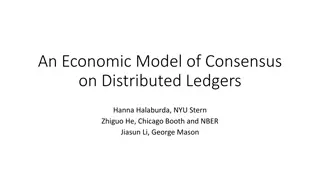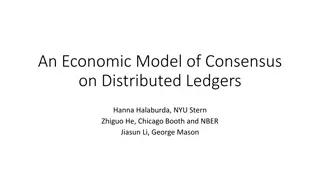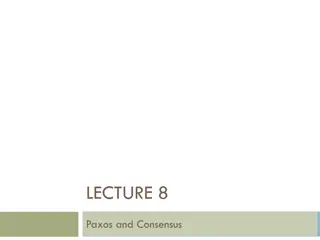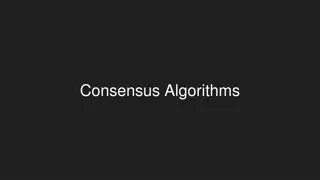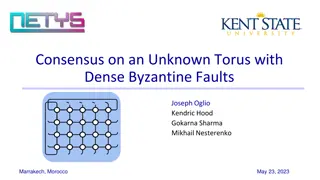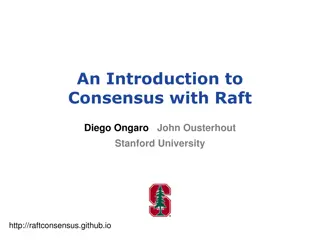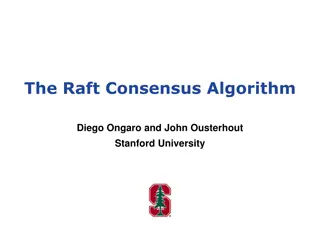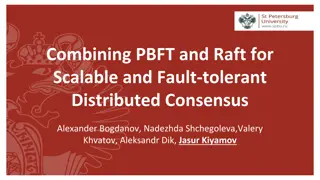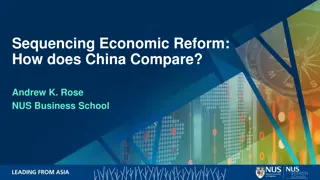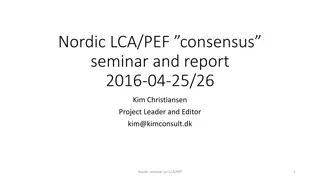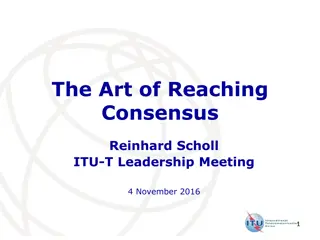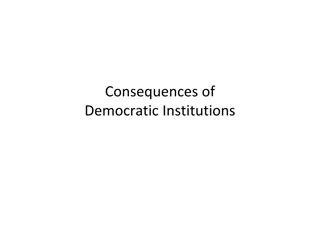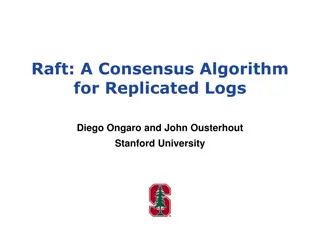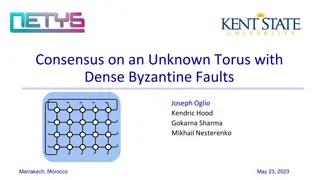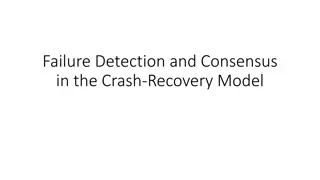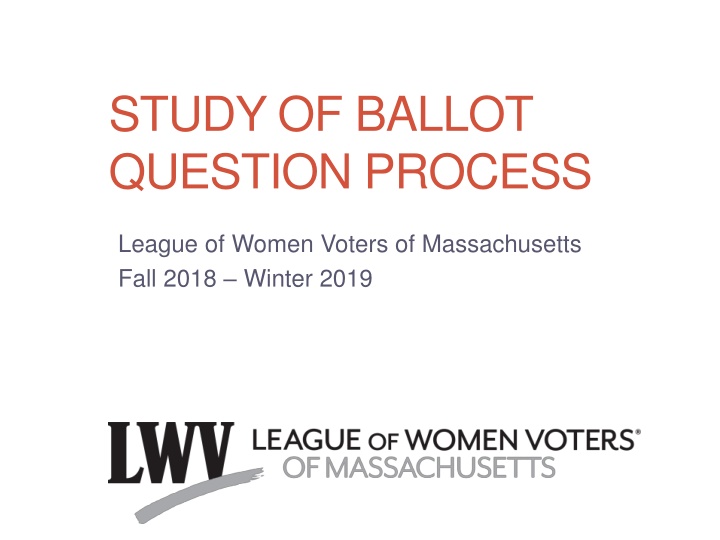
The Ballot Question Process in Massachusetts
Explore the study conducted by the League of Women Voters of Massachusetts in the Fall of 2018 and Winter of 2019 to educate members about the ballot question process in Massachusetts. Discover the goals, consensus methodology, types of ballot questions, and the history of initiative and referendum in Massachusetts.
Download Presentation

Please find below an Image/Link to download the presentation.
The content on the website is provided AS IS for your information and personal use only. It may not be sold, licensed, or shared on other websites without obtaining consent from the author. If you encounter any issues during the download, it is possible that the publisher has removed the file from their server.
You are allowed to download the files provided on this website for personal or commercial use, subject to the condition that they are used lawfully. All files are the property of their respective owners.
The content on the website is provided AS IS for your information and personal use only. It may not be sold, licensed, or shared on other websites without obtaining consent from the author.
E N D
Presentation Transcript
STUDY OF BALLOT QUESTION PROCESS League of Women Voters of Massachusetts Fall 2018 Winter 2019
2 Study Goals Educate LWV members about the ballot question process in MA At each League, consider, through consensus meetings, possible changes to the process LWVMA develops a position based on the answers to the consensus questions from each League Members vote on the position at Convention 2019 LWVMA can propose steps to enact any recommended changes to the process
3 What Is Consensus? Collective opinion, general agreement Not a vote! Voting is no substitute for the informal and meaningful give and take of discussion and agreement. Members participate in a group discussion. The consensus reached by members through group discussion is not a simple majority, nor is it unanimity, but refers to the overall sense of the group. One individual cannot simply declare a block to consensus. No Consensus is an acceptable response, but the group must agree that there is no consensus.
4 Ballot Questions in MA Statewide Citizen-initiated Law Constitutional amendment Referendum on an existing law Statewide Legislature-initiated Constitutional amendment Advisory (nonbinding) US Constitutional questions (nonbinding) District or Municipality Advisory to legislator (nonbinding) Tax 2 1/2% overrides, charter change, etc. Focus of this study
5 Initiative and Referendum in US 18 of the 24 states west of the Mississippi; 8 of 26 east of the Mississippi
6 Initiative and Referendum in MA Started in 1918 with Constitutional Amendment Article XLVIII (48) First election with citizen-initiated ballot question was 1919 Standing Initiative and Referendum Committee vote to bring amendment forward (7 no, 8 yes) Lengthy debate at Constitutional Convention resulted in official written record of 1100 pages Supporters wanted to cure the evils that have grown up in Massachusetts representative form of government Dissenters predicted: Initiative will not really reflect the will of the people, but that of small groups Voters will not be sufficiently informed No debate, amendment, or compromise possible
7 Types of Questions in MA 1919 - 2018 # of Questions on the Ballot since 1919 # of Questions Approved % Approved Type of Question Initiative Petition for a Law 82 37 45.1% Initiative Petition for a Constitutional Amendment Legislative Constitutional Amendment Referendum Petition on an Existing Law 3 2 66.6% 63 53 84.1% 21 11 52.4% Legislative Advisory Question 13 8 61.5% U.S. Constitutional Amendment (Advisory) 3 1 33.3%
PROCESSES IN MA Initiative for Law Initiative for Constitutional Amendment Referendum on an Existing Law
9 Law or Constitutional Amendment (1) 10 registered voters sign on as proponents Submit fully developed proposed law or constitutional amendment Apply to AG Measure is not the same as any measure which has been qualified for submission or voted on at either of the two preceding biennial statewide elections Measure contains only subjects related or mutually dependent and not excluded from the initiative process by Article XLVIII AG certifies per constitution Per constitution fair, concise Appears on petition, and will appear on official voter guide and ballot AG prepares summary AG: Attorney General
10 Article XLVIII Excluded Subjects Relates to religion, religious practices or religious institutions; Relates to the appointment, qualification, tenure, removal, recall or compensation of judges, or the reversal of a judicial decision, or the powers, creation or abolition of courts; Is restricted in its operation to a particular town, city or other political division or to particular districts or localities of the Commonwealth; Makes a specific appropriation of money from the treasury of the Commonwealth; Is inconsistent with any of the following state constitutional rights: Right to receive compensation for private property appropriated to public use Right of access to and protection in courts of justice Right of trial by jury Protection from unreasonable search, unreasonable bail and the law martial Freedom of the press Freedom of speech Freedom of elections Right of peaceable assembly
11 Law or Constitutional Amendment (2) SOC prepares petition sheets Proponents collect 64,750+ valid signatures Proponents collect signaures Town/city election officials confirm signature eligible SOC counts number of signatures according to rules for petition signature collection Signatures checked & counted Different legislative process for law vs. constitutional amendment Laid before Legislature SOC: Secretary of the Commonwealth
12 Law Approve as written Law passes, no BQ Take no action No vote is taken Approve a similar new law on the issue Possible Legislature Actions In latter two cases, proponents decide whether to proceed toward ballot question Proponents Collect 10,792+ new and different signatures Submit as before, signatures approved and counted Collect more signatures Approved for Ballot after 15 months
13 Constitutional Amendment Joint session 1st Legis session, 25% to approve Joint session 2nd Legis session, 25% to approve Legislature First session does not have 25% No BQ First session approves, 2nd does not No BQ Joint session adjourns before vote No BQ Possible Negative Outcomes If two consecutive joint sessions approve (25%), proponents decide whether to proceed with ballot question Proponents Approved for Ballot after 39 months
14 Court Challenges Attorney General s original decision on constitutionality may be challenged in court at any time Challenge that AG should have certified petition can go forward for signatures awaiting court decision on whether it can go to the ballot or not If court decides AG should not have certified ballot question cannot not go forward
15 Referendum on an Existing Law 10 registered voters identify law they want repealed Must submit signed petition to SOC within 30 days of it becoming law Apply to AG AG prepares a summary of the existing law Ensures it is not excluded from the referendum process by Article XLVIII AG certifies & prepares summary 32,375 to vote on referendum at next election 43,167 to suspend the law until a vote on referendum at next election Signature Collection
16 Referendum Timing Event Timing Submission of petition to SOC by ten original signers SOC has petition forms prepared for collection of required number of signatures Filing of petitions with local registrars for certification Not later than 30 days after act is signed by Governor (or passed over his veto) Within 14 days after summary is prepared by AG By 14 days before filing deadline with SOC Within 90 days after the act is signed by the Governor (or passed over his veto) Filing certified petitions with the SOC Petitions submitted to the voters; Suspended law immediately null and void if law disapproved First state election 60 or more days after filing certified petitions with the SOC STATE ELECTION DAY Next state election Effective Date 30 days after election
17 Referendum on an Existing Law Prior to 2018, referendum process was last used in 1998. The initiative for law process can also be used to repeal laws Repeal by referendum vs. initiative for law Referendum requires fast initiation and completion of process 90 days for whole process Referendum is on entire law. Initiative for law may be used to repeal all or part of an existing law or create a new law. Referendum requires fewer signatures (~33,000 collected once vs. ~76,000 in two rounds)
18 2018 Election: Initiatives for Law 27 petitions submitted to Attorney General (AG) 20 certified by AG (deemed constitutional); 1 collected signatures without certification 6 petitions had sufficient signatures collected 1 challenged in court and stopped 3 withdrawn after Legislature s grand bargain 2 petitions for laws on the November 2018 ballot (Q 1 & 2)
19 2018 Election: Initiatives for Constitutional Amendment In 2015 AG certified constitutional amendment millionaires tax (for 2018 ballot) Sufficient signatures collected Tax income over $1million at higher rate to fund transportation and education Passed 25% of 2 joint sessions of Legislature In 2018 challenged in court and ballot question stopped
20 2018: Referendum on an Existing Law The transgender rights law was passed in 2016, signatures were collected in 2016 to put referendum question on the ballot At the next election, November 6, 2018, a vote to keep the anti-transgender discrimination law is Question 3 The Legislature has the power to pass a new anti- transgender discrimination law at any time
21 Voter Information Official document is Information for Voters prepared by Secretary of the Commonwealth Recognizable red booklet Mailed to residences of all registered voters prior to the election, posted on Elections webpage Specific information on each ballot question
Information for Voters (Red Booklet) Component Length Preparer Ballot Question Number SOC Ballot Question Title short SOC+AG Not longer than required components Concise The Question SOC Summary AG What Your Vote Will Do 1 sentence each SOC+AG Statement of Fiscal Consequences Arguments in favor and against Full text of question Sec. of Administration & Finance Principal proponent and opponent chosen by SOC As submitted by proponents 100 words 150 words each No limit
23 Initiatives in Other States Direct vs. Indirect process Direct process legislature has no role Indirect process the legislature has a role 21 States with initiatives for laws 14 have direct initiative process 9 have indirect process, including MA Note: 2 states have both direct and indirect 18 states with initiatives for constitutional amendments 16 direct 2 indirect, including MA
24 Initiative & Referendum Other States Each of 26 states has its own set of laws and regulations No federal regulations govern ballot questions Background for each consensus question includes some information on what other states do relative to that question Study Committee looked at a subset of the 26 states based on volume of ballot questions and regional representation
25 Ballot Question Campaign Finance Ballot Question campaign committee is any group that raises or spends money (including in-kind) in support of or opposition to a ballot question Must register with MA Office of Campaign and Political Finance (OCPF) before spending Must follow regulations for reporting income and expenses on a pre-specified schedule All reports are posted on the OCPF website as soon as filed Final report received after the election
26 Ballot Question Campaign Finance Unlike donations to candidates, no limits on individual contributions to ballot question committees. There are regulations concerning dark money contributions. OCPF identified four cases of reporting violations by campaign committees in 2016. Spending on ballot questions increased sharply in 2014 and again in 2016 and in 2018.
27 Total Spending on Ballot Questions $57.5 million $70,000,000 $60,000,000 $50,000,000 $40,000,000 $30,000,000 $20,000,000 $10,000,000 $-
CONSENSUS QUESTIONS Let s get started!
29 Materials for Consensus Meeting Study Guide Consensus Questions Quick Reference and Outcome Sheet For Consensus Questions 1-5: Information for Voters 2018 Red Booklet For Consensus Question 2: Appendix 3 For Consensus Question 3: Citizens Initiative Review 2016 and 2018
SECTION I Understanding the Ballot Questions Refer to Information for Voters red booklet, 2018
31 Question 1 Should additional efforts be made to ensure petition summaries are written for the greatest understanding by voters? Yes No No consensus
32 Question 2 (refer to Appendix 3) 2A. Do the statements of fiscal consequences in the "Information for Voters" red booklets from 2016 and 2018 provide voters with the information they need to make an informed decision on the potential fiscal impact of passing the ballot question(s)? Yes No No consensus 2B. Should voter information beyond the 100-word statement of fiscal consequences found in the Information for Voters red booklet be available, such as through public meetings, webinars, telephone call-ins, websites, etc.? Yes No No consensus
33 Question 3 (refer to Citizens Initiative Review) Should the arguments in favor and against in the Information for Voters red booklet be prepared by an independent source such as a citizen group appointed for that purpose rather than, or in addition to, the proponents and opponents identified by the Secretary of the Commonwealth? Yes No No consensus
34 Question 4 Should there be a limit to the length (e.g., number of words or number of pages) of the full text of a proposed law for an initiative petition (and eventual ballot question)? Yes No No consensus
35 Question 5 Should the Secretary of the Commonwealth periodically review and update the means of disseminating and publicizing the Information for Voters red booklet? Yes No No consensus
SECTION II Signature Requirements
37 Question 6 Currently there is a limitation on the number of signatures that can be certified from any one county. (NOTE: Answer yes or no to both A and B.) 6A. Should that limitation be modified to reflect population variation while still ensuring geographic dispersion of signatures? Yes No No consensus 6B. Should that limitation be eliminated? Yes No No consensus
38 Question 7 Should every identifiable, unique signature on a petition be counted toward the required total, rather than rejecting, for example, all signatures on a page because of one error or stray mark? Yes No No consensus
39 Question 8 In a petition for law, a second round of signatures must be collected after the legislature has had time to act. Only signatures from registered voters who did not sign the first round can be counted. Should this second round be eliminated? Yes No No consensus
SECTION III Signature Gathering
41 Question 9 Should there be regulations governing signature collectors? Yes No No consensus
42 Question 10 Should the Secretary of the Commonwealth provide training opportunities for signature collectors? Yes No No consensus
SECTION IV Legislative Involvement and Responsibilities
44 Question 11 An initiative petition for a constitutional amendment requires two votes, one in each of two successively elected Legislatures. Should the second vote be eliminated? Yes No No consensus
45 Question 12 Should there be a period during which the legislature is not allowed to change a citizen-initiated law passed or repealed by ballot question? Yes No No consensus
SECTION V Campaign Financing for Ballot Questions
47 Question 13 Should Massachusetts seek ways to limit the amount of money that can be spent on ballot question campaigns? Yes No No consensus
48 Question 14 Should accurate information on campaign donations to and expenditures from ballot question committees be available to the public prior to the election? Yes No No consensus
SECTION VI Initiative and Referendum Process in Massachusetts
50 Question 15 Should the current initiative and referendum process by which citizens can do the following (A-C) be retained? 15A. Initiate laws Yes No No consensus 15B. Initiate constitutional amendments Yes No No consensus 15C. Repeal laws through referendum Yes No No consensus




